 One Click...
One Click...
to all things local!
North 10th Street, A 19th Century Tour
Note: This is the web-based incarnation of a brochure originally published in 1980. While the history is still very valuable, other information may no longer be accurate. Information updated by WayNet will be listed in this orange color.
Introduction
We are very pleased to give you herewith a walking tour of "our town" and a small portion of what remains of a once great architectural heritage.
One must always keep in mind that we have lost much in the the past, but we of Old Richmond, Inc. are sincerely hopeful that we have now reached an "awakening period" where at least we hopefully will lose no more architectural gems in the false name of "progress".
If we can only succeed in convincing our politicians and general citizenry that anyone at all can raze and destroy, but only a true artisan can create, then we can be satisfied in feeling that our avowed mission to save those structures worthy of preservation will have been accomplished.
Please bear in mind that this tour is something that will never be again. If this doesn't create an interest, then we shall have no one to blame when future generations raze the things that we held significant in our lives.
Executive Board, Old Richmond, Inc.
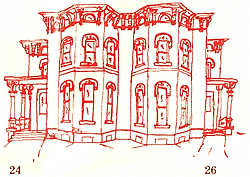 24-26 North 10th Street
24-26 North 10th Street
Dr. James E. Taylor is believed to have been one of the early owners of this Italianate double situated northwest of Sailors St.. No. 24 was used as his residence and 26 as his office. It is believed that this structure was built around 1870.
In 1898, while practicing medicine in Richmond, Dr. Taylor did physicals for soldiers in the Richmond Company F section of the 161st Indiana Infantry. He originated from Ohio and while studying medicine in Michigan, he was active in the drug business. He also attended Miami Medical College and the Cincinnati Medical College. He was a member of the G.A.R. and trustee of the Smith Home for Women. (24) Jake and Fred (26) Miller of Pogue, Miller and Co. later acquired this building. It has since been razed and now serves as a parking lot.
 28-30-32-34 North 10th Street
28-30-32-34 North 10th Street
This multiple-family building was razed in 1970 and is presently a parking lot. It was erected in 1878 by Charles T. Price, Sr. Mr. Price was a shoe dealer who came from Philadelphia. Records show that the land for the structure was purchased from Caroline G. Boyce in 1987.
C.T. Price built a very large number of homes in Richmond and laid out four additions to the city of Richmond.
General Telephone (Richmond Home Telephone Co.) purchased the first of the four family unites in 1950. A second unit was purchased in 1962, with the last two units being purchased from Mr. and Mrs. Charles Pollet in 1969.
The structure with its dormer windows and iron railing around the balcony stoops, is reminiscent of eastern townhouses.
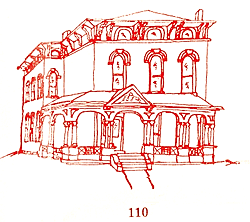 110 North 10th Street
110 North 10th Street
Known as the George Miller Home, this fine example of Italianate architecture was razed in 1956 to make way for an addition to the First Presbyterian Church.
This structure had 12 rooms and was built of brick sometime between 1877 and 1881 by W. N. Kendall. Mr. Kendall purchased the property in 1877 from William E. Bell.
The home was lived in by the widow of Mr. Miller until 1951. Mr. Miller purchased the home in 1896 from Charles C. Binkley.
Mr. Binkley was a Richmond attorney and secretary of the Cincinnati, Richmond and Fort Wayne Railroad. He purchased the home from Mr. George Upp in 1895.
Mr. George Upp purchased the property from Clara Kendall in 1892.
Mrs. Kendall acquired the property from Lilly Kendall in 1881. Lilly Kendall controlled the property for only one day and acquired the property from W.N. Kendall who was a member of Kendall, Barnes and Co., linseed oil manufactures.
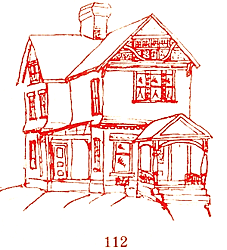 112 North 10th Street
112 North 10th Street
Dr. Charles S. Bond was a principle resident of this large Neo-Jacobean house. Dr. Bond was a member of the Wayne Co. Medical Association and numerous other organizations. He was born in Wayne County, June 8, 1856. He attended Earlham College, and Antioch, taught 6 years, and then studied medicine in the Ohio Medical College at Cincinnati receiving a Dr. of Medicine degree from Bellevue Hospital Medical College in 1883. He was one of four men chosen to give the valedictorian address. In 1887, he received the Dr. of Science and Masters of Science degrees from Earlham. He also was one of the founders of Saint Stephens Hospital.
In 1883 he married Julia M. Boyd.
 126 North 10th Street
126 North 10th Street
This beautifully restored mansion in the Italianate mode was the Augustus C. and Andrew F. Scott home.
Augustus C. Scott is listed primarily as a stock dealer while Andrew F. was an original stockholder of the First National Bank of Richmond in 1863. He also became the first director, an original officer, and president of the Second National Bank until his death in 1895. The 2nd National bailed out both the Farmers Bank in Boston and the Richmond National Bank in 1884 when they ran short of money.
The house was willed to the Wayne County Historical Museum in 1977 and when the restoration is completed it will be opened to the public. (2008 - once again privately owned.)
It is one of the few remaining housed in which several generations of the same family lived, leaving the house in almost original condition.
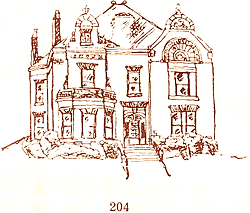 204 North 10th Street
204 North 10th Street
This delightful Victorian/Neo-Jacobean house was built in approximately 1874 by W. G. Scott of high quality imported brick and terra cotta, it is presently the home of the Knights of Columbus, who acquired it in 1921.
Research indicated that John B. Dougan purchased it from Mrs. W. G. Scott There is some confusion as to the exact date this structure was built because of a prior structure known as 202, which, it is believed, was owned by W. G. Scott and was razed so that the present building could be erected at the same location. Speculation could also indicate that the original structure was partially razed and then an extensive renovation done.
The barn to the rear of this structure is believed to also have been built prior to the Civic War at the same time as the original structure.
William G. Scott was a cousin of Andrew F. Scott who resided just south of his home.
Wm. G. Scott and Andrew F. Scott were presidents of the Second National Bank. John B. Dougan was its fourth president, serving from 1900 to 1914.
Daniel G. Reid, who previously resided at 302 N. 10th, acquired the property from his half-brother, J. B. Doughan. Mr. Reid's daughter, Mrs. Henry (Rhea Reid) Topping sold the property to the Knights of Columbus in 1921. Mr. Reid's grandson, Daniel Reid Topping, was co-owner of the New York Yankees at that time.
The barn to the rear of the structure was razed in 1962 so that the K. of C. could expand their clubhouse. The barn served as a bottling facility for the Nehi Bottling Company, and the garage space for the Palladium-Item.
The Scotts and the Dougans used the brick barn to keep teams of horses which drew their carriages around town.
Wm. G. Scott married Malinda Gaar, daughter of Jonas Gaar, and became a member of the Gaar Machine works, later re-named Gaar, Scott, and Co.
 208 North 10th Street
208 North 10th Street
This 12 room brick Neo-Jacobean house was built by Wm. G. Scott, father of Mrs. John Dougan, for Mr. and Mrs. John Dougan was razed in 1959 for additional parking spaces for the Stegall-Berheide-Orr funeral home and the Knights of Columbus clubhouse.
The structure was built, approximately, in the early 1890's.
It is believed that an earlier structure existed on this location with an address of 206 and was razed so that this structure could be built.
Some of the owners and residents of this house were Henry C. Starr, a Richmond attorney; Charles A. McGuire; and Addison H. Gist who purchased the property in 1923.
Mr. Gist was a dentist and had real estate interests. Hinson's Health Institute was the last owner of this property.
 222 North 10th Street
222 North 10th Street
This exceptionally fine Italianate structure situated on lots 192-193 of the Charles W. Starr addition to the city of Richmond is believed to have been built by A. W. Mendenhall for John Milton Gaar (1823-1900) and sold to James E. Reeves.
Mr. Reeves moved into the house on March 13th, 1863. He was the son of Mark Reeves and was born in New Jersey. After a varied career he and his brother became charter stockholder's of 1st National Bank and became its first president. He was also president of Champion Roller Milling C., aided in the organization of the Richmond City Mill works, and helped effect the purchase and building of the Morrisson-Reeves Library.
Mr. Reeves was affiliated with Purdue University as Treasurer of the Agricultural College.
After his death, Mrs. Reeves sold the house in 1904, to John F. Miller and moved to 200 South 16th Street.
Mr. J.F. Miller was associated with Pogue Miller & Co., a railroad magnate, and founder of Glen Miller Park.
The Moose Lodge purchased the structure in 1916, used it as it's lodge and in 1927 sold the house to Stegall Bros.
The original owner of the land was Jon Meek in 1805. Mr. Meek was the brother of Jeremiah, an early Wayne County Judge.
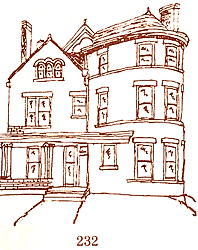 232 North 10th Street
232 North 10th Street
The present structure at 232 was built on lot 194 after the demolition of the smaller structure shown below. Lot 194, known as 252 N. 10th Street, was sold by Arthur W. Mendenhall to John Milton Gaar, father of Mrs. Jos. B. Craighead, in 1857 when it is believed the smaller structure was erected.
The present large eclectic with classical architectural influences is believed to have been built in the 1890's by Joseph B. Craighead. Records indicate that the smaller structure was owned by Mr. Craighead also.
Mr. Craighead was vice president of the Gaar Scott Co. and secretary of the Richmond Water Works.
The front part of the home has cherry woodwork and a very elaborate entrance and stairway.
 308 North 10th Street
308 North 10th Street
This Romanesque/Victorian house built in the 1890's by William P. Hutton contained 19 rooms, three ornate mantels and fireplaces, and an open stairway from the first to the third floor. As with many houses built during this time, it also had hardwood floors with inlaid patterns.
W.P. Hutton was president of the J.M. Hutton Company, casket makers. He was also treasurer of the Richmond Water Works Company.
In or around 1902, Edgar F. Hiatt, then treasurer of the Dickinson Trust Company, bought the home and had it dismantled and moved to 2018 Main Street, the site of the now defunct Red Barn (Red Nails / Sub 'n Roll).
According to research, the structure was dismantled with the stone pieces of the front and sides being numbered for proper reassembly.
In 1905 the ownership transferred to George R. Williams, a bookkeeper at the Gaar, Scott Co.
Gaar Williams, a Richmond native who became a noted cartoonist for the Chicago Tribune, was a son of George R. Williams.
The 308 N. 10th street site was then used, along with the land under the D.G. Reid house for the present Day Care Building.
 314 North 10th Street
314 North 10th Street
A neo-Jacobean/Victorian structure built in the 1870's was the home of Mathew and Emily Hutton Dill. According to research, it is believed that Mrs. Dill's father, Mr. Hutton, had the house built for them.
Mr. Dill was secretary of the J.M. Hutton Co, vice president of Richmond Bridge, and treasurer of the Richmond City Water Works.
Until September of 1977, the house had beautiful stained glass windows in the curved stairway.
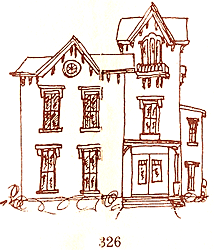 326 North 10th Street
326 North 10th Street
"High Tower" as the home of James M. Starr has become known, was built about 1870 by Elizabeth Starr, Charles W. Starr's widow. The original grant of land from the Federal Government was signed by President James Monroe in 1811. C.W. Starr purchased this land, an area of 240 acres from Jeremiah Cox, in the year 1826 and built a small federal house just to the north of this structure.
The third of ten children, James M. Starr married Lydia C. Briggs who died about three years after their marriage. His second wife was Sarah Jane King, a daughter of Levinus King.
James M. Starr was a prime source of funding for a piano company in 1872 later to become known as, "the house of Starr", Starr Piano Company.
Henry D. Chapin purchased this home and lived there until 1909. Charles and Gertie Klop, their daughter Elizabeth, and son Bert resided there between 1909 and 1925. The Klops boarded and entertained theatrical people who came to Richmond to perform at the Murray Theatre.
Miss Elizabeth continued her dance studio in this home until hear death in 1969.
It is believed that a log cabin stood on the side of this eclectic high Victorian.
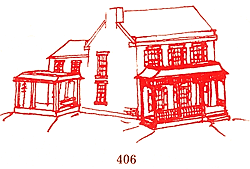 N.W. Corner of 10th and D Street (406)
N.W. Corner of 10th and D Street (406)
Pictured below is the residence of Charles West Starr. This modest appearing Federal home is believed to have been constructed in about 1826, when Mr. Starr bought 240 acres from Jeremiah Cox. It was razed in the 1890's for the Richmond Water Works building.
The West in Mr. Starr's name was his mother's maiden name. She was a cousin of Benjamin West, noted Philadelphia painter who moved to England and never returned to the United States.
Before coming to Richmond in 1825 Starr had learned the carpenter's trade in Philadelphia, engaged in the coasting trade between Charleston, S. C. and Philadelphia, and operated a lumber business in Charleston.
It was hoped that Richmond would become a manufacturing town and Mr. Starr did a great deal to accomplish this goal. Before he died in 1855, he tried to insure the success of Richmond by donating the land of the Pennsylvania Railroad station as well as land east of it, to the Richmond and Miami Railroad in 1850.
Elizabeth Starr continued where Charles left off and had to deal with some reported rivalry between herself and Robert Morrison, Joseph Plummer, John Smith and others of the west end of Main Street.
The Starrs also operated a popular tavern/hostelry on the old transcontinental highway. It was in operation from 1846 to 1854 and was razed to make room for the Dickinson Trust Building, which has also been razed and is the site of the present Second National Bank Building. (Fifth Third Bank)
Benjamin Starr was also a primary resident at this address. Being born there in 1842, he was the first of the 10 Starr children.
He served in Company C. 2nd Indiana Cavalry in 1861 and was engaged in the skirmishes enroute to Corinth, Pea Ridge, Tuscumbra, McMinnville, and Gallatin. In Gallatin, Benjamin was wounded in the head, was stricken with typhoid fever and fortunately recovered to become secretary and treasurer of Starr Piano Co.
(Revised: He served in Company C, 2nd Indiana Cavalry from September 1861 until September 1862. He was engaged in the skirmishes at Tuscumbia, MS, and McMinnville and Gallatin, TN. At Gallatin Benjamin was wounded in the head and was also stricken with typhoid fever. Fortunately he recovered and became the secretary and treasurer of the Starr Piano Co.)
He was one of the incorporators of the Cincinnati, Richmond and Muncie Railroad.
As a republican, he served as a member of council of administration of the G.A.R., trustee of the Soldiers and Sailor's Orphans Home at Knightstown, member of the board of regents of the Indiana Soldiers and Sailor's monument and as a member of the Richmond School Board.
In 1902 he was elected, unopposed as state senator from Wayne County, but died while in office.
He was married twice, first to Josephine Iredell who died in 1868, then to Mary Longstreet. They had a daughter Lydia who removed to Chicago.
407 North 10th Street
This structure, believed to have been built in 1863-64 for or by Noah S. Leeds of Vanuxem and Leeds and then the N.S. Leeds and Co., later became the residence of Henry E. Robinson.
Mr. Robinson was born in Richmond on October 10th, 1839, the son of Francis W. Robinson (I). He was educated in Richmond's schools and when the Civil War broke out, he enlisted.
As a soldier in the Fifty-seventh Indiana infantry, which was in the Fifth and Eleventh Congressional districts and was organized in Richmond in 1861, he left the state and reported to General Buell at Louisville, where he was assigned to the sixth division, army of the Ohio, and ordered to Bardstown, KY. He was involved in the siege of Corinth and moved from there to northern Alabama, then back to Tennessee and took an active part in the campaign against Bragg in Kentucky, being in the battle of Perryville. Illness forced his discharge and upon recovering he went to Indianapolis where he became associated with an express company. He later returned to Richmond and became a partner with his father in the Robinson Machine Works. He was made vice-president of the company when it was incorporated in 1889 as Robinson and Company, and when his father died in 1897, Mr. Robinson was chosen president, continuing in that position till his death, January 9, 1909.
The house was razed and the Atlas Underwear Company built a fine structure on the site, now however, it is merely a warehousing facility (Atlas Senior Apartments).
 321 North 10th Street
321 North 10th Street
Isaac R. Howard of the firm I.R. Howard & Co. wholesale grocers, 202 & 204 Fort Wayne Avenue resided in this interesting, large, and fine Italianate home probably built in the early 1860's.
Mr. Howard was a native of Henry County, Indiana where he was raised and educated. In 1860 he moved to Richmond to become a partner in a wholesale grocery business known as Howard and Grubbs. In 1871 he built the 63 by 200 foot two story brick building on Fort Wayne Avenue to house it.
His house was razed and is the site of the Howard apartment complex, itself an interesting form of housing when it was built.
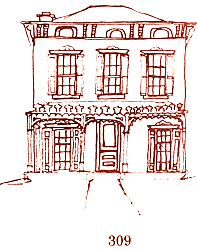 309 North 10th Street
309 North 10th Street
The house known as the John F. Robbins home is another example of Italianate architecture and was built between 1858-60. Mr. Robbins was an attorney and the father of Phillip and Byram Robbins, also attorneys.
Mr. Robbins was proprietor of Robbins and Starr, later known as Robbins and Robbins.
In the rendering below, a front porch is evident. It was probably added in the 1890's and the house presently appears as it appeared when it was built.
 301 North 10th Street
301 North 10th Street
This 1859-60 Italianate home was owned by Stephen Wiggins of Wiggins and Co.
Wiggins and Co. made saddles for the cavalry during the Civil War.
 205 North 10th Street
205 North 10th Street
This Second Empire (French) mansard roofed dormered, brick structure was built about 1860 by William McWhinney who was listed as a clerk.
John W. Grubbs later acquired the property as a residence. Mr. Grubs was president of the J. W. Grubbs & Co. and is reported to have started several newspapers in the area.
John W. Grubbs was identified with the wholesale grocery trade in Richmond for nearly 33 years. Mr. Grubbs and I.R. Howard, both of New Castle, Ind., formed a partnership in 1860 when they purchased the wholesale grocery stock of James M. Starr. This early firm was known as Howard and Grubbs Wholesale Grocers and its store was located on the west side of Fort Wayne Ave. in the block north of the Pa. Railroad.
Mr. Howard withdrew and organized the firm of I.R. Howard and Co. Wholesale Grocers. The original firm operated under the name of John W. Grubbs Co. Shortly after World War I, the J.W. Grubbs Co. acquired the I.R. Howard Co. and moved form its old location of 200-205 Ft. Wayne Ave. In 1927, the John W. Grubbs Co. Disposed of it's business to the J. C. Perry & Co. Wholesale Groceries.
William F. Starr became a partner in the J.W. Grubbs Co., as John Grubbs was his father-in-law. Following the death of Mr. Grubbs, he became president and served as such for more than 30 years.
W. F. Starr, the son of Mr. and Mrs. James F. Starr was born in 1846 on his parents' farm on Chester Pike north of Spring Grove. He married the eldest daughter of J. W. Grubbs, Florence.
Mr. Starr purchased the house in 1910. In the mid 1900's, the house was converted into a tenement building and remains that way today.
127 North 10th Street
This early Italianate changed into a Classical Palladian or Georgian-styled house was originally lived in by Andrew and W.G. Scott. It later became the home and office of Dr. Charles Marvel. Dr. Marvel, in the early 1900's, almost doubled the size of the house by adding the south portion, and changing the overall effect of the house to its present style. The front and side porches have been removed.
Dr. Marvel was a member of the Wayne County Medical Association and had his office at the north side of the house.
The house became the Richmond City Schools Administration offices until they were moved into their present building on Whitewater Blvd. (Hub Etchison Parkway).
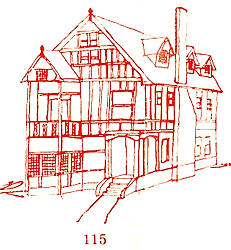 115 North 10th Street
115 North 10th Street
Mrs. John M. Gaar sold her 8th Street home to the Elks and had this English Tudor structure built in 109 for herself and her daughter, Mrs. William B. Leeds. Research indicated that another structure was razed so that this one might be erected.
The Tudor home of Mrs. Leeds was razed in September of 1974 to make room for an expanded parking lot for Palladium-Item employees.
Mrs. Jeannette G. Leeds, former president of the Palladium Publishing Co. and her son, Rudolph Leeds, editor and publisher of the Palladium-Item lived here until Mr. Leeds moved to his new residence on South 18th Street. That residence was also razed and the Masons' Temple is presently on the 18th Street site.
109 North 10th Street
The Federal style house built in the 1850's on the site that is presently a parking lot was the home of the Honorable Daniel Webster Comstock.
 Mr.
Comstock was born in 1840, and was graduated from Ohio Wesleyan
University, Delaware, Ohio in 1860. His father was Dr. James
Comstock and his grandfather was a soldier in the Revolution. In
1861 he was both living in New Castle and admitted to the Bar.
He was elected district attorney for the Eleventh Common Pleas in
1862. In 1865, he enlisted in the 9th Indiana Cavalry and was
promoted to 1st lieutenant of Company F and then discharged in 1865
whereupon he became a resident of Richmond.
Mr.
Comstock was born in 1840, and was graduated from Ohio Wesleyan
University, Delaware, Ohio in 1860. His father was Dr. James
Comstock and his grandfather was a soldier in the Revolution. In
1861 he was both living in New Castle and admitted to the Bar.
He was elected district attorney for the Eleventh Common Pleas in
1862. In 1865, he enlisted in the 9th Indiana Cavalry and was
promoted to 1st lieutenant of Company F and then discharged in 1865
whereupon he became a resident of Richmond.
In Richmond he was elected city attorney. In 1867 he married Josephine A. Hohre, they had two daughters, Elizabeth and Clara, who resided at this address until their deaths, and a son Paul.
Further, he was elected and served as prosecuting attorney in 1872 and 1874, state senator in 1878, and Judge of the Seventeenth Judicial Circuit in 1884 and 1890.
In 1896, he became Judge of the 4th District Appellate court and served there until 1911. Upon retiring, he practiced law with his son Paul and was a member of the Taconite Society.
The house was torn down by the Palladium Publishing Co. in October of 1967 to make a parking lot.
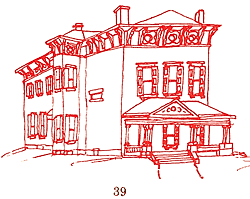 39 North 10th Street
39 North 10th Street
This large, brick Italianate house built by E.G. Vaughan in 1872 was razed in 1964 for a carwash-filling station by the Good Oil Company.
In the 14 rooms that his irreplaceable home had, there were probably 8-10 fireplaces, ornate plaster work friezes and medallions, ornate woodwork in walnut, mahogany or oak, a ballroom on the third floor and many other no longer available features.
23 North 10th Street
Daniel B. Crawford lived at this address when it was known as 4 North 7th Street in 1870. Mr. Crawford was born in Maryland. When in Richmond, he was associated with D.B. Crawford & Son, Dry Goods. He became Director of The First National Bank, Richmond City Mill Works and the Wayne Co. Turnpike Co. He was an active member of the Sons of Temperance and, it is recorded, was so zealous he wouldn't let apples be turned into cider.
Around 1891 Thomas Nixon of Thomas Nixon & Co. acquired the property. At the present time there is no picture available of this house.
 15 North 10th Street
15 North 10th Street
The present Greek Revival facade of this 1860 structure was added about 1901, probably shortly after it became the Pohlemeyer Funeral Home.
The structure is situated on lot 167 and part of 168 in the Charles W. Starr Addition and believed to have cost $1,000 when built by W.W. Lynde some time between 1859 and 1864. In 1864 Mr. Curtis B. Huff, who was an original stockholder in the First National Bank of Richmond purchased the property. He then sold it to Dr. Verlin Kersey in 1878.
Dr. Kersey was born in 1809 in Guilford County, North Carolina. He was one of the founders of the Indiana State Medical Society which held its first convention in Indianapolis in the year of 1849. He was elected president of the Society in 1866.
Dr. Kersey also founded the Taconite Society, better known as the "Talk and Eat" which met mostly in the winter months.
When Dr. Kersey died in 1875, the property passed to Richard Kersey, then to Folger P. Wilson and Henry J. Pohlemeyer to be used as a funeral home.
Acknowledgements:
- Illustrations and Editor: Lucian A. Szlizewski
- Old Richmond Inc. Board of Directors
- Morrisson-Reeves Library
- Ball State University Library
- Earlham College Library
- Palladium-Item
- Printed by The Graphic Press
Text and illustrations © 1980, Old Richmond, Inc.
![]()
![]()
![]()
![]()
Location
North 10th Street, Richmond, Indiana between Main and North E Streets.
Hours / Admission
Public Access / Free
Credit
This information was taken from a brochure copyrighted by Old Richmond, Inc. in 1980.
Permission to publish this information was given to WayNet.org by:
Preserve Richmond
P.O. Box 1709
Richmond, IN 47345
Acknowledgements
~Illustrations and Editor -
Lucian A. Szlizewski
~Old Richmond Board of Directors
~Morrisson-Reeves Library
~Ball State University Library
~Earlham College Library
~Palladium-Item
~Original Brochure Printed by The Graphic Press
|
This jQuery slider was created with the free EasyRotator software from DWUser.com.
Need a powerful Flash slideshow creator with built-in iPhone/iPad/Android support? EasyRotator is supported by the XML Flash Slideshow v4 Software. OK |
This jQuery slider was created with the free EasyRotator software from DWUser.com.
Need a powerful Flash slideshow creator with built-in iPhone/iPad/Android support? EasyRotator is supported by the XML Flash Slideshow v4 Software. OK |
|
This jQuery slider was created with the free EasyRotator software from DWUser.com.
Use WordPress? The free EasyRotator for WordPress plugin lets you create beautiful WordPress sliders in seconds. OK |
This jQuery slider was created with the free EasyRotator software from DWUser.com.
Use WordPress? The free EasyRotator for WordPress plugin lets you create beautiful WordPress sliders in seconds. OK |
Featured Member
Community Photo
More Photos:
Wayne County | WayNet Albums
Did You Know?
Wayne County Fast Facts
| Location: | East Central Indiana, USA |
| Founded: | 1810 |
| Population: | 66,456 |
| Elevation: | 1,257 feet Highest Point in Indiana |
| County Seat: | Richmond |
| Local Time: | |
| Date: | |
| About Indiana: | IN.gov |
| Current Weather: |
Follow Us
Contact Us
| Email: | info@waynet.org |
| Phone: | 765.939.0857 |
| Mail: | 50 North 5th St. Richmond, IN 47374 |
| Director: | Board of Directors |
Stay in Touch
Sign up for WayNet News
- our e-newsletter.
Translate This Page
Join WayNet
About WayNet
Waynet, Inc. is a non-profit, 501(c)4 corporation that is fully-funded through memberships. Please support our members and let them know you located them via WayNet.org.
Top 25: popular pages & circulation information.
Our Recent Tweets
Copyright © Waynet, Inc. 2022, All Rights Reserved.| Policies
Directory | News | Discover | Find It Fast | Knowledge | To Do | Members

























